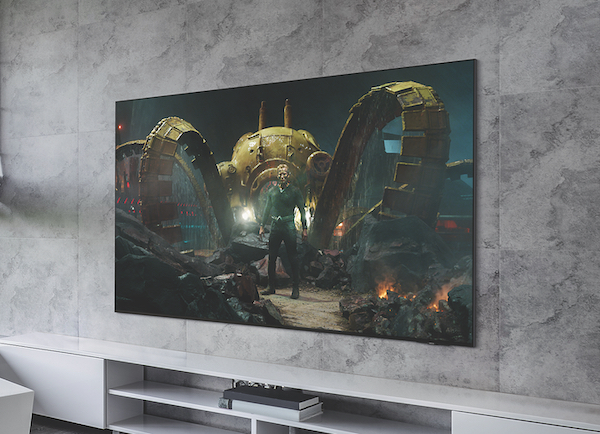Samsung QE65S95D 4K OLED TV review

 The first TV from Samsung's 2024 range is a QD OLED flagship on an HDR mission. John Archer investigates
The first TV from Samsung's 2024 range is a QD OLED flagship on an HDR mission. John Archer investigatesWhile it took Samsung much longer than, well, just about everyone else to fully board the OLED TV train, the South Korean company seems eager to make up for lost time. In 2024 it is significantly expanding its OLED offering, even dipping down to 48in on a new, entry-level lineup, and with its flagship S95D series, tested here at 65in, it's also seeking to rewrite the OLED performance rule book.
Priced at a premium £3,499, the QE65S95D runs an upgraded Neo Quantum 4K processor to drive the latest generation of Samsung's Quantum Dot OLED screen technology to the full extent of its capabilities. In particular, this mean it becomes easily the brightest OLED model in the company's range.
In fact, a measured peak brightness in its Movie and Filmmaker Mode presets of over 1,700 nits (on a 10 per cent white test window), and over 2,100 nits in Standard mode on a two per cent HDR window, make it the brightest OLED TV we've yet seen – although we expect incoming rival models to be similarly boosted.
Box clever
The home for all this 4K HDR bedazzlement is suitably sleek, albeit familiar. Like its S95C predecessor, the QE65S95D has an ultra-narrow metallic finish bezel around its screen, while the rear sticks out barely a centimetre across its entire spread – possible because its connections, power and processing are housed in one of Samsung's One Connect boxes, which links to the TV
via a single discreet cable. And despite its slimness, there's space for a row of eight rear-facing drivers around the back, part of the QE65S95D's 70W-rated, 4.2.2-channel 'object tracking sound' system.

Aside from that near 30 per cent brightness boost, this TV's main new feature is an anti-reflection filter technology, named 'OLED Glare Free', which we're told 'overcomes the trade-off between gloss and reflection thanks to a new, specialized hard-coating layer and surface coating pattern.' The idea here is that by drastically reducing reflections, a particular scourge of daytime viewing, subjective picture quality is improved.
The TV's new brightness talents aren't just down to improvements to the QD OLED hardware (which, to recap, shines a blue organic light through red and green QD layers, avoiding the need for the white element used in traditional WRGB OLEDs). As usual Samsung has been tinkering its processing platform, this time adding an 'HDR OLED Pro' element which uses deep learning to detect and enhance which parts of the picture need to be either darker or brighter, then intelligently diverting power accordingly.
The company also says its Neo Quantum 4K AI Gen 2 chipset is built around the collective learning of 20 neural networks, enabling the 65S95D to be more effective at first recognising the type of content being played, and then choosing the best settings for that particular source type.
Other new tools introduced by the processor are improved 'perceptional colour mapping', which uses AI (again) to deliver more natural, balanced colours (as approved by colour experts Pantone, no less), plus an AI Auto Game mode which aims to optimise picture and sound to the type of game content. It can also now automatically detect where a game's 'mini-map' is, making it easier for you to magnify it or even move it to a second screen.
On the subject of gaming, the 65S95D's four HDMI inputs are all able to pass 4K/120Hz gaming graphics with HDR and variable refresh rates (actually, 144Hz is achievable if you have a talented PC). The VRR support includes AMD's Freesync Premium Pro iteration. There's a dedicated game setup menu, too.
Smart features, including apps for key UK TV catch-up services, again come via Samsung's Tizen system. New for this season is a helpful 'For You tab' that provides direct access to both recently watched shows from your favourite streaming platforms or broadcast channels, as well as content recommendations. Two remote controls are supplied, one button-heavy and conventional, the other a slinky, solar- and Wi-Fi-powered unit that works well for most day to day functions.
Controlled aggression
Groundbreaking though last year's S95C TVs were, their pictures could sometimes feel a bit 'out there'. It's therefore notable that, despite containing much more brightness and colour volume, the 65S95D's images feel more under control, without becoming in the least bit boring.
The enormous brightness boost this OLED enjoys is certainly the most instantly impactful thing about its pictures. Whether it's an ultra-bright highlight like the massive mirrors used to illuminate Immortan Joe's cave in the 4K Blu-ray of Mad Max: Fury Road, or a sunny daylight exterior such as any of the film's desert battle sequences, the 65S95D excels with its life-like intensity and purity.

There are a few premium LCD TVs that can go brighter still, with the right content, but none can offer pixel-level light control, meaning they're no match for the precision of the 65S95D's brightness peaks, especially when they appear within an otherwise darker shot.
This all helps sell the HDR experience effectively, but it's not overblown. There's nothing remotely vulgar or wanton about this screen's extraordinary brightness. Presumably thanks to Samsung's new-generation processor, the extra light range is applied carefully enough to avoid obvious clipping of shading details. It also unlocks impressive volumes of colour for OLED technology, without tones succumbing to a cartoonish or unbalanced look.
Contrast king
The HDR transfer on the Fury Road 4K BD contains some of the trickiest colours around: take your pick from shifting desert sands; subtly shaded blue skies and sunsets; sun-darkened or powder-whitened skin tones; gleaming car bodywork; and a non-stop parade of flame-throwers and explosions. It looks monumentally good on the 65S95D, rather than gaudy and distracting.
The film is also packed with moments of rich contrast, an area where Samsung's new set appears in complete control. In the pre-credits sequence where Max tries to escape his cave-dwelling captors, there are dynamic brightness peaks besides inky, natural black colours, the latter as effortlessly deep as we've come to expect from OLED technology. Small bright areas emerge with real punch in a way that is particularly mesmerising.
4K TVs have now been around for long enough that we shouldn't be stunned by their sharpness, but the 65S95D still manages to turn heads in this regard. Its remarkably diverse but also accurately applied light and colour toning contributes to a fantastic sense of sharpness, detail and, especially, texture in Fury Road's sandy environments and rugged vehicles and outfits, or the cleaner, sci-fi trappings of the Chris Pratt/Jennifer Lawrence double-header Passengers (4K BD). This resolution also feels like a natural result of the screen's lighting precision, rather than something forced through sharpening processing.
Samsung's default Picture Clarity settings ensure pretty much no resolution is lost through either judder or motion blur, thanks to potent frame interpolation. This can, however, cause 24fps images to get so smooth they no longer look cinematic, as well as throwing up quite a few flickering and haloing side effects. A Custom Picture Clarity setting, with judder and blur reduction tools, can be tweaked for a better all-round look.
The 65S95D's inherent superb picture quality works wonders with games as well as movies and TV. Like the earlier S95C, its Game mode setting offers extremely rapid responses time (sub-10ms), but playing Baldur's Gate 3 benefits from improvements to colour vibrancy and contrast, while again maintaining better control of the brightest highlights and boldest colours.
On reflection
I haven't yet mentioned the 65S95D's anti-glare filter, which is a seriously heavy-duty affair, reminiscent of
the system that makes Samsung's The Frame designer TVs look more like paintings than regular screens.
It dissipates light from such reflective nasties as windows, wall lights, standing lamps and so on remarkably effectively, as well as rendering general reflections and light pollution pretty much nonexistent. The extent to which this lets you forge a direct connection with what you're watching, even in a bright room, is uncanny.
Yet OLED Glare Free has a couple of side effects. First, while black levels remain immaculate in a dark viewing environment, they can become slightly elevated in a bright room, which in turn can affect colour tones. The filter also appears to contribute to a faint trace of bloom around very bright objects if they appear in a dark setting. For most regular room setups, however, the pros outweigh the cons.
Another niggle, not related to the anti-glare filter, is a gentle brightness instability when using the 65S95D's otherwise hard-to-resist Standard preset, seemingly caused by the screen compensating its brightness for some reason (maybe to limit the risk of permanent image retention?) for slight changes in the picture.
This preset can also see the occasional very bright HDR highlight take on a bluish effect, while grainy sources, such as Blade Runner (4K BD), can feel a touch too grainy during very bright/very dark scenes. The Standard mode, in keeping with most Samsung TVs, can also cause some details to become lost in shadows. The excellent Movie preset fixes this problem pretty much completely, without sacrificing excessive amounts of brightness, contrast or colour intensity.
Must-see TV
The 65S95D's sound matches the precision of its pictures, bringing out even subtle effects from Fury Road's Dolby Atmos mix and placing them with accuracy on (and slightly off) the screen. The slenderness of the TV, however, seems to limit the air-shifting potential of its rear-facing drivers, preventing bass from reaching as deep as I'd like.
The solution, of course, is to pair Samsung's premium flatscreen with an external audio system. And if that involves extra outlay on top of the £3,499 of the TV itself, it'll be fully justified. The 65S95D offers a must-see 4K HDR performance.
HCC Verdict: 5/5
Samsung QE65S95D
Price: £3,499
www.samsung.com
We say: Samsung's third generation of Quantum Dot OLED TV takes its panel and processing technology to new brightness and colour highs – without succumbing to any showboating.
Specifications
4K: Yes. 3,840 x 2,160 HDR: Yes. HDR10, HLG, HDR10+ CONNECTIONS: 4 x HDMI inputs; RF tuner; 3 x USB; optical audio output; Ethernet 4K/120 PLAYBACK: Yes SOUND (CLAIMED): 70W, 4.2.2-channel BRIGHTNESS (CLAIMED): Not given CONTRAST: Not given DIMENSIONS (OFF STAND): 1,444(w) x 829(h) x 11(d)mm WEIGHT (OFF STAND): 18.9kg
FEATURES:Quantum Dot OLED screen technology; Neo Quantum 4K AI Gen 2 processor; anti-glare filter; HDR OLED Pro brightness and contrast enhancement; perceptional colour mapping; all HDMIs handle 4K/120Hz and VRR (including AMD Freesync Premium Pro); Bluetooth; Wi-Fi; AI Auto Game detection; Game Bar dedicated gaming menu; Freeview HD tuner
 |
Home Cinema Choice #351 is on sale now, featuring: Samsung S95D flagship OLED TV; Ascendo loudspeakers; Pioneer VSA-LX805 AV receiver; UST projector roundup; 2024’s summer movies; Conan 4K; and more
|


















































